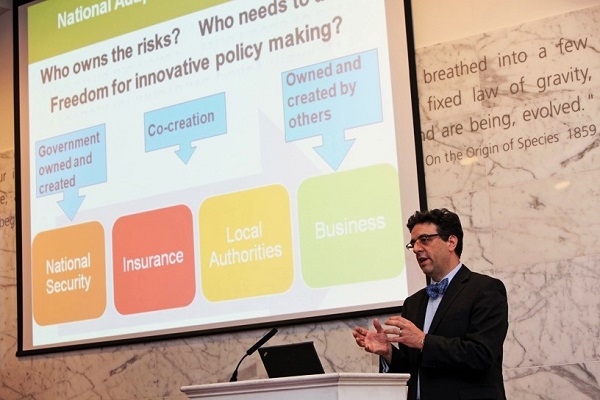What are we concerned about?
There is a high degree of confidence that the world’s climate is changing

Defra civil servant explaining the Government's adaptation plans in 2012 © Climate UK
On this page:
Introduction
Many of the services provided by local authorities and other local organisations are likely to be affected by climate change. Increased flooding over the last few years and the severe winter storms of 2013/14, resulting in people being forced out of their homes and disruption to businesses and services, have increased the profile of our changing climate. With climate change, these types of events are likely to become more frequent, as the UK is identified as an area at risk from the more immediate effects of global warming. High summer temperatures are also likely to increase, which could result in drought conditions, as well as more frequent heatwaves.
Responsibilities and priorities
Local authorities have responsibilities for promoting wellbeing in economic, social and environmental terms and should be considering how to actively prepare for climate change to ensure that their communities, particularly those that are most vulnerable, are resilient to future impacts. Other local organisations, such as housing associations, emergency services and healthcare clinical commissioning groups also have responsibilities to support our most vulnerable communities, now and in the future.
Increasing the resilience of our communities, businesses, infrastructure and natural environment to the impacts of severe weather and climate change should be a key priority. This will be important to ensure our sustained economic prosperity, to maintain and enhance environmental quality and to ensure our health and wellbeing within a fair and just society. There is a wealth of support and advice available to enable organisations, in all sectors, to understand the potential threats and opportunities that climate change is likely to bring, but less guidance concerning the ‘How do I do it?’ question.
Identifying who is vulnerable
The Joseph Rowntree Foundation’s Climate Change and Social Justice programme, which this website draws upon, provides a wealth of evidence about vulnerable people and places in the UK. Work includes mapping indicators which help to explain the factors that make people more or less vulnerable to the impacts of climate change. In addition to environmental factors which might increase the impacts of specific climate hazards (e.g. living in certain types of housing), individual and social characteristics are identified which relate to people’s personal sensitivity and their ability to prepare for, respond to and recover from the impacts of climate change. The map tool can be used to identify which communities are likely to be most vulnerable to climate change and which may have the greatest exposure to flooding (e.g. living close to rivers or in areas exposed to surface water flooding) and high temperatures (e.g. living in areas with the highest summer maximum temperatures in the 2050s). Local datasets can be used to supplement the information provided in these maps as appropriate.
Having a clear identification of the people and communities who may be most affected is a crucial starting point. Furthermore, those affected need to have a say in the types of actions and responses that are developed to help them to adapt. This resource sets out:
- Why adaptation planning is important at the local level
- Where action is needed
- How to develop an adaptation action plan
- Further resources that may help you to improve resilience in your local community.
References

Built by:

© 2014 - Climate Just
Contact us
